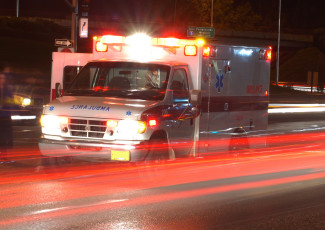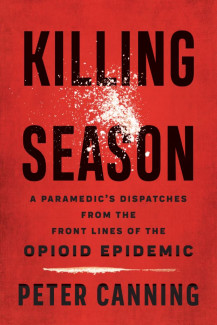
Johns Hopkins UniversityEst. 1876
America’s First Research University
Now Browsing:
Killing Season: A Paramedic's Dispatches from the Front Lines of the Opioid Epidemic

When I started as a 911 paramedic on the streets of Hartford, Connecticut over twenty-five years ago, I believed drug users were victims of their own character flaws. They lacked personal responsibility and their behavior was criminal. Keep using drugs, I’d tell them, and you will end up dead or in jail, which many of them did.
Today, my views on drug users are different. As the overdoses escalated, I began asking my patients how they got started on their perilous journeys. While no two tales were the same, they shared unremitting similarities. I heard the phrase over and over “I used to be a normal person once.”
Emily was a cheerleader who broke her back when her teammates dropped her. Chloe, abandoned by her heroin user mother as a child, tried heroin herself to find out what made her mother love heroin more than her. Tom volunteered for the armed forces the day after 9-11 and returned from Iraq with a purple heart and a terrible addiction to pain pills.
My patients’ entries into addiction – whether through legal drugs prescribed by their doctors following injury or illness, offered by a friend to help with nagging pain, or through experimentation, innocent or otherwise – spun them into tortuous futures they could not have foreseen, and from which, for many, there was no escape.

The voices of my patients moved me to educate myself about the science of addiction, and, armed with that understanding, to fight against the stigmatization of users. I know now that addiction is a chronic brain disease, whose victims deserve our empathy, support, and kindness. I know users are not riff-raff; they are our brothers, sisters, parents, dear friends, neighbors, and members of our communities, who are victims of a disease in the same way as those who suffer from heart, lung, body and other debilitating maladies and disabilities are victims of their diseases. I know now that stigma—the way many view and treat drug users negatively—drives users into the shadows where they die alone with no one to call 911 or administer naloxone when they encounter an unexpectedly potent dose.
Today I embrace harm reduction, a strategy that accepts that people are going to use drugs and works to minimize the negative consequences of their drug use. It recognizes that many people use drugs because drugs work for them, keeping them from the horrible sickness of withdrawal and blunting the pain, both physical and mental that the years and events in their lives have wrought upon them. Harm reduction helps people stay alive until they are in a place where they are open to change and able to receive help.
Instead of telling my patients who use drugs to just say no, I offer them avenues to recovery. If they are not ready for treatment, I tell them how to use drugs safely. Don’t use alone, I say. Do a tester shot if you’ve bought from a new dealer or batch. Don’t mix opioids with benzos. Always have naloxone available. Call 911 if someone overdoses. I tell them where they can get clean needles, how to treat their skin to avoid abscesses and I warn them about dangerous batches on the street. I have, when posted in my ambulance in certain neighborhoods, even had people openly use within my sight, knowing that they were safe to have me watching over them.
As a paramedic, I have always kept journals about the job and the patients I have encountered, often writing in the ambulance front seat in between 911 dispatches, trying to make sense of what I am feeling and experiencing. I wrote Killing Season so others could hear the voices of my patients, see what I have seen on overdose scenes and their critical aftermaths, and undergo the same journey I did, learning that drug users are people as normal as you or me before they encountered, through whatever means, the opioids that spiraled their lives out of control.
In addition to the stories of patients and emergency calls, my book explores the history of the opioid epidemic, the war on drugs, pain management, the science of addiction, the dangers of the synthetic opioid fentanyl, and the need for safe injection sites.
I hope people will join me in fighting stigma, embracing harm reduction and focusing our country and communities on saving and restoring lives, and helping the lost find their way home.
Order Killing Season: A Paramedic's Dispatches from the Front Lines of the Opioid Epidemic at the following link: https://jhupbooks.press.jhu.edu/title/killing-season
Peter Canning, the EMS coordinator at UConn John Dempsey Hospital, has worked for more than twenty-five years as a full-time ambulance paramedic. He is the author of Killing Season: A Paramedic's Dispatches from the Front Lines of the Opioid Epidemic, Paramedic: On the Front Lines of Medicine, and Rescue 471: A Paramedic's Stories.

Today, my views on drug users are different. As the overdoses escalated, I began asking my patients how they got started on their perilous journeys. While no two tales were the same, they shared unremitting similarities. I heard the phrase over and over “I used to be a normal person once.”
Emily was a cheerleader who broke her back when her teammates dropped her. Chloe, abandoned by her heroin user mother as a child, tried heroin herself to find out what made her mother love heroin more than her. Tom volunteered for the armed forces the day after 9-11 and returned from Iraq with a purple heart and a terrible addiction to pain pills.
My patients’ entries into addiction – whether through legal drugs prescribed by their doctors following injury or illness, offered by a friend to help with nagging pain, or through experimentation, innocent or otherwise – spun them into tortuous futures they could not have foreseen, and from which, for many, there was no escape.

The voices of my patients moved me to educate myself about the science of addiction, and, armed with that understanding, to fight against the stigmatization of users. I know now that addiction is a chronic brain disease, whose victims deserve our empathy, support, and kindness. I know users are not riff-raff; they are our brothers, sisters, parents, dear friends, neighbors, and members of our communities, who are victims of a disease in the same way as those who suffer from heart, lung, body and other debilitating maladies and disabilities are victims of their diseases. I know now that stigma—the way many view and treat drug users negatively—drives users into the shadows where they die alone with no one to call 911 or administer naloxone when they encounter an unexpectedly potent dose.
Today I embrace harm reduction, a strategy that accepts that people are going to use drugs and works to minimize the negative consequences of their drug use. It recognizes that many people use drugs because drugs work for them, keeping them from the horrible sickness of withdrawal and blunting the pain, both physical and mental that the years and events in their lives have wrought upon them. Harm reduction helps people stay alive until they are in a place where they are open to change and able to receive help.
Instead of telling my patients who use drugs to just say no, I offer them avenues to recovery. If they are not ready for treatment, I tell them how to use drugs safely. Don’t use alone, I say. Do a tester shot if you’ve bought from a new dealer or batch. Don’t mix opioids with benzos. Always have naloxone available. Call 911 if someone overdoses. I tell them where they can get clean needles, how to treat their skin to avoid abscesses and I warn them about dangerous batches on the street. I have, when posted in my ambulance in certain neighborhoods, even had people openly use within my sight, knowing that they were safe to have me watching over them.
As a paramedic, I have always kept journals about the job and the patients I have encountered, often writing in the ambulance front seat in between 911 dispatches, trying to make sense of what I am feeling and experiencing. I wrote Killing Season so others could hear the voices of my patients, see what I have seen on overdose scenes and their critical aftermaths, and undergo the same journey I did, learning that drug users are people as normal as you or me before they encountered, through whatever means, the opioids that spiraled their lives out of control.
In addition to the stories of patients and emergency calls, my book explores the history of the opioid epidemic, the war on drugs, pain management, the science of addiction, the dangers of the synthetic opioid fentanyl, and the need for safe injection sites.
I hope people will join me in fighting stigma, embracing harm reduction and focusing our country and communities on saving and restoring lives, and helping the lost find their way home.
Order Killing Season: A Paramedic's Dispatches from the Front Lines of the Opioid Epidemic at the following link: https://jhupbooks.press.jhu.edu/title/killing-season
Peter Canning, the EMS coordinator at UConn John Dempsey Hospital, has worked for more than twenty-five years as a full-time ambulance paramedic. He is the author of Killing Season: A Paramedic's Dispatches from the Front Lines of the Opioid Epidemic, Paramedic: On the Front Lines of Medicine, and Rescue 471: A Paramedic's Stories.
Login to View & Leave Comments
Login to View & Leave Comments


